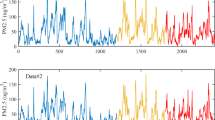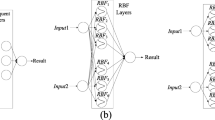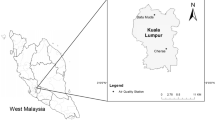Abstract
PM2.5 forecasting technology can provide a scientific and effective way to assist environmental governance and protect public health. To forecast PM2.5, an enhanced hybrid ensemble deep learning model is proposed in this research The whole framework of the proposed model can be generalized as follows: the original PM2.5 series is decomposed into 8 sub-series with different frequency characteristics by variational mode decomposition (VMD); the long short-term memory (LSTM) network, echo state network (ESN), and temporal convolutional network (TCN) are applied for parallel forecasting for 8 different frequency PM2.5 sub-series; the gradient boosting decision tree (GBDT) is applied to assemble and reconstruct the forecasting results of LSTM, ESN and TCN. By comparing the forecasting data of the models over 3 PM2.5 series collected from Shenyang, Changsha and Shenzhen, the conclusions can be drawn that GBDT is a more effective method to integrate the forecasting result than traditional heuristic algorithms; MAE values of the proposed model on 3 PM2.5 series are 1.587, 1.718 and 1.327 µg/m3, respectively and the proposed model achieves more accurate results for all experiments than sixteen alternative forecasting models which contain three state-of-the-art models.
摘要
PM2.5预测技术可为环境治理和保护公众健康提供科学依据。为预测PM2.5,本文提出一种新的混合集成深度学习模型。整个模型可以描述为:利用变分模态分解(VMD)将原始PM2.5序列分解为8 个不同频率特性的子序列,采用长短期记忆网络(LSTM)、回声状态网络(ESN)和时间卷积网络(TCN)对8 个不同频率PM2.5子序列进行并行预测,采用梯度增强决策树(GBDT),对LSTM、ESN和TCN的预测结果进行集成重构。基于采集于沈阳、长沙和深圳3 个城市的PM2.5数据进行实验,得出以下结论:相对于传统的启发式集成方法,GBDT是一种更有效的集成优化方法。本文所提出模型在3 个实验数据集上的MAE分别为1.587、1.718 和1.327 µg/m3,相对于其他16 个对比模型,本文所提出预测模型具有更优秀的预测性能。
Similar content being viewed by others
References
GAN Kai, SUN Shao-long, WANG Shou-yang, et al. A secondary-decomposition-ensemble learning paradigm for forecasting PM2.5 concentration [J]. Atmospheric Pollution Research, 2018, 9(6): 989–999. DOI: https://doi.org/10.1016/j.apr.2018.03.008.
KAPPOS A D, BRUCKMANN P, EIKMANN T, et al. Health effects of particles in ambient air [J]. International Journal of Hygiene and Environmental Health, 2004, 207(4): 399–407. DOI: https://doi.org/10.1078/1438-4639-00306.
LIANG Chun-sheng, DUAN Feng-kui, HE Ke-bin, et al. Review on recent progress in observations, source identifications and countermeasures of PM2.5 [J]. Environment International, 2016, 86: 150–170. DOI: https://doi.org/10.1016/j.envint.2015.10.016.
GRELL G A, PECKHAM S E, SCHMITZ R, et al. Fully coupled “online” chemistry within the WRF model [J]. Atmospheric Environment, 2005, 39(37): 6957–6975. DOI: https://doi.org/10.1016/j.atmosenv.2005.04.027.
DJALALOVA I, DELLE MONACHE L, WILCZAK J. PM2.5 analog forecast and Kalman filter post-processing for the Community Multiscale Air Quality (CMAQ) model [J]. Atmospheric Environment, 2015, 119: 431–442. DOI: https://doi.org/10.1016/j.atmosenv.2015.05.057.
HUANG Jian-ping, MCQUEEN J, WILCZAK J, et al. Improving NOAA NAQFC PM2.5 predictions with a bias correction approach [J]. Weather and Forecasting, 2017, 32(2): 407–421. DOI: https://doi.org/10.1175/waf-d-16-0118.1.
QU Xu, WANG Wei, WANG Wen-fu, et al. Real-time rear-end crash potential prediction on freeways [J]. Journal of Central South University, 2017, 24(11): 2664–2673. DOI: https://doi.org/10.1007/s11771-017-3679-2.
SUN Wei, SUN Jing-yi. Daily PM2.5 concentration prediction based on principal component analysis and LSSVM optimized by cuckoo search algorithm [J]. Journal of Environmental Management, 2017, 188: 144–152. DOI: https://doi.org/10.1016/j.jenvman.2016.12.011.
ABDULLAH S, NAPI N N L M, AHMED A N, et al. Development of multiple linear regression for particulate matter (PM10) forecasting during episodic transboundary haze event in Malaysia [J]. Atmosphere, 2020, 11(3): 289. DOI: https://doi.org/10.3390/atmos11030289.
AGARWAL S, SHARMA S, R S, et al. Air quality forecasting using artificial neural networks with real time dynamic error correction in highly polluted regions [J]. Science of the Total Environment, 2020, 735: 139454. DOI: https://doi.org/10.1016/j.scitotenv.2020.139454.
ARSOV M, ZDRAVEVSKI E, LAMESKI P, et al. Multi-horizon air pollution forecasting with deep neural networks [J]. Sensors, 2021, 21(4): 1235. DOI: https://doi.org/10.3390/s21041235.
KALAJDJIESKI J, ZDRAVEVSKI E, CORIZZO R, et al. Air pollution prediction with multi-modal data and deep neural networks [J]. Remote Sensing, 2020, 12(24): 4142. DOI: https://doi.org/10.3390/rs12244142.
BAI Yun, ZENG Bo, LI Chuan, et al. An ensemble long short-term memory neural network for hourly PM2.5 concentration forecasting [J]. Chemosphere, 2019, 222: 286–294. DOI: https://doi.org/10.1016/j.chemosphere.2019.01.121.
XU Yi-nan, LIU Hui, DUAN Zhu. A novel hybrid model for multi-step daily AQI forecasting driven by air pollution big data [J]. Air Quality, Atmosphere & Health, 2020, 13(2): 197–207. DOI: https://doi.org/10.1007/s11869-020-00795-w.
JIANG Fu-xin, ZHANG Cheng-yuan, SUN Shao-long, et al. A novel hybrid framework for hourly PM2.5 concentration forecasting using CEEMDAN and deep temporal convolutional neural network [OL] arXiv preprint [2020-12-07]. https://arxiv.orglabs/2012.03781.
CHENG Yong, ZHANG Hong, LIU Zhen-hai, et al. Hybrid algorithm for short-term forecasting of PM2.5 in China [J]. Atmospheric Environment, 2019, 200: 264–279. DOI: https://doi.org/10.1016/j.atmosenv.2018.12.025.
LIU Hui, JIN Kai-rong, DUAN Zhu. Air PM2.5 concentration multi-step forecasting using a new hybrid modeling method: Comparing cases for four cities in China [J]. Atmospheric Pollution Research, 2019, 10(5): 1588–1600. DOI: https://doi.org/10.1016/j.apr.2019.05.007.
ZHOU Qing-ping, JIANG Hai-yan, WANG Jian-zhou, et al. A hybrid model for PM2.5 forecasting based on ensemble empirical mode decomposition and a general regression neural network [J]. Science of the Total Environment, 2014, 496: 264–274. DOI: https://doi.org/10.1016/j.scitotenv.2014.07.051.
HUANG Jia-hao, LIU Hui. A hybrid decomposition-boosting model for short-term multi-step solar radiation forecasting with NARX neural network [J]. Journal of Central South University, 2021, 28(2): 507–526. DOI: https://doi.org/10.1007/s11771-021-4618-9.
CAO Hong-rui, FAN Fei, ZHOU Kai, et al. Wheel-bearing fault diagnosis of trains using empirical wavelet transform [J]. Measurement, 2016, 82: 439–449. DOI: https://doi.org/10.1016/j.measurement.2016.01.023.
LIU Scarlett, WANG Quan-dong, LUO Yi-ping. A review of applications of visual inspection technology based on image processing in the railway industry [J]. Transportation Safety and Environment, 2020, 1(3): 185–204. DOI: https://doi.org/10.1093/tse/tdz007.
WU Qun-li, LIN Hua-xing. Daily urban air quality index forecasting based on variational mode decomposition, sample entropy and LSTM neural network [J]. Sustainable Cities and Society, 2019, 50: 101657. DOI: https://doi.org/10.1016/j.scs.2019.101657.
ZHAO Hai-ming, ZHAO Xiang, HAN Feng-lin, et al. Cobalt crust recognition based on kernel Fisher discriminant analysis and genetic algorithm in reverberation environment [J]. Journal of Central South University, 2021, 28(1): 179–193. DOI: https://doi.org/10.1007/s11771-021-4595-z.
GAYATHRI DEVI K S, SUJATHA THERESE P. Optimized PI controller for 7-level inverter to aid grid interactive RES controller [J]. Journal of Central South University, 2021, 28(1): 153–167. DOI: https://doi.org/10.1007/s11771-021-4593-1.
SONG Jing-jing, WANG Jian-zhou, LU Hai-yan. A novel combined model based on advanced optimization algorithm for short-term wind speed forecasting [J]. Applied Energy, 2018, 215: 643–658. DOI: https://doi.org/10.1016/j.apenergy.2018.02.070.
LIANG Wei-zhang, LUO Sui-zhi, ZHAO Guo-yan, et al. Predicting hard rock pillar stability using GBDT, XGBoost, and LightGBM algorithms [J]. Mathematics, 2020, 8(5): 765. DOI: https://doi.org/10.3390/math8050765.
LI Long-jie, YU Yang, BAI Shen-shen, et al. Towards effective network intrusion detection: A hybrid model integrating gini index and GBDT with PSO [J]. Journal of Sensors, 2018, 2018: 1578314. DOI: https://doi.org/10.1155/2018/1578314.
MAO Xing-liang, LI Fang-fang, LIU Xi-yao, et al. Detection of artificial pornographic pictures based on multiple features and tree mode [J]. Journal of Central South University, 2018, 25(7): 1651–1664. DOI: https://doi.org/10.1007/s11771-018-3857-x.
ZHANG Xiao, WANG Xiao-rong, CHEN Wei, et al. A taxi gap prediction method via double ensemble gradient boosting decision tree [C]//2017 IEEE 3rd International Conference on Big Data Security on Cloud. Beijing, China: IEEE, 2017: 255–260. DOI: https://doi.org/10.1109/BigDataSecurity.2017.27.
DRAGOMIRETSKIY K, ZOSSO D. Variational mode decomposition [J]. IEEE Transactions on Signal Processing, 2014, 62(3): 531–544. DOI: https://doi.org/10.1109/tsp.2013.2288675.
ZHANG Dan, PENG Xian-gang, PAN Ke-da, et al. A novel wind speed forecasting based on hybrid decomposition and online sequential outlier robust extreme learning machine [J]. Energy Conversion and Management, 2019, 180: 338–357. DOI: https://doi.org/10.1016/j.enconman.2018.10.089.
THUROW K, CHEN Chao, JUNGINGER S, et al. Transportation robot battery power forecasting based on bidirectional deep-learning method [J]. Transportation Safety and Environment, 2020, 1(3): 205–211. DOI: https://doi.org/10.1093/tse/tdz016.
JAEGER H. The “echo state” approach to analysing and training recurrent neural networks-with an erratum note [R]. Bonn: Ger Ger Natl Res Cent Inf Technol, 2001: 148.
ZHONG Shi-sheng, XIE Xiao-long, LIN Lin, et al. Genetic algorithm optimized double-reservoir echo state network for multi-regime time series prediction [J]. Neurocomputing, 2017, 238: 191–204. DOI: https://doi.org/10.1016/j.neucom.2017.01.053.
LIU Hui, LONG Zhi-hao, DUAN Zhu, et al. A new model using multiple feature clustering and neural networks for forecasting hourly PM2.5 concentrations, and its applications in China [J]. Engineering, 2020, 6(8): 944–956. DOI: https://doi.org/10.1016/j.eng.2020.05.009.
LEA C, FLYNN M D, VIDAL R, et al. Temporal convolutional networks for action segmentation and detection [C]// 2017 IEEE Conference on Computer Vision and Pattern Recognition. Honolulu, HI, USA: IEEE, 2017: 1003–1012. DOI: https://doi.org/10.1109/CVPR.2017.113.
BAI Shao-jie, KOLTER J Z, KOLTUN V. An empirical evaluation of generic convolutional and recurrent networks for sequence modeling [OL]. arXiv preprint [2018-04-19]. https://arxiv.org/abs/1803.01271.
HU Jun-jie, ZHOU Huayanran, ZHOU Yi-hong, et al. Flexibility prediction of aggregated electric vehicles and domestic hot water systems in smart grids [J]. Engineering, 2021, 7(8): 1101–1114. DOI: https://doi.org/10.1016/j.eng.2021.06.008.
HE Yang-dong, ZHAO Jia-bao. Temporal convolutional networks for anomaly detection in time series [J]. Journal of Physics: Conference Series, 2019, 1213(4): 042050. DOI: https://doi.org/10.1088/1742-6596/1213/4/042050.
FRIEDMAN J H. Greedy function approximation: A gradient boosting machine [J]. The Annals of Statistics, 2001, 29(5): 1189–1232. DOI: https://doi.org/10.1214/aos/1013203451.
FRIEDMAN J H. Stochastic gradient boosting [J]. Computational Statistics & Data Analysis, 2002, 38(4): 367–378. DOI: https://doi.org/10.1016/S0167-9473(01)00065-2.
LIU Hui, DUAN Zhu, WU Hai-ping, et al. Wind speed forecasting models based on data decomposition, feature selection and group method of data handling network [J]. Measurement, 2019, 148: 106971. DOI: https://doi.org/10.1016/j.measurement.2019.106971.
WU Hai-ping, LIU Hui, DUAN Zhu. PM2.5 concentrations forecasting using a new multi-objective feature selection and ensemble framework [J]. Atmospheric Pollution Research, 2020, 11(7): 1187–1198. DOI: https://doi.org/10.1016/j.apr.2020.04.013.
LI Yan-fei, LIU Zhe-yu, LIU Hui. A novel ensemble reinforcement learning gated unit model for daily PM2.5 forecasting [J]. Air Quality, Atmosphere & Health, 2021, 14(3): 443–453. DOI: https://doi.org/10.1007/s11869-020-00948-x.
SUN Wei, LI Zhao-qi. Hourly PM2.5 concentration forecasting based on mode decomposition-recombination technique and ensemble learning approach in severe haze episodes of China [J]. Journal of Cleaner Production, 2020, 263: 121442. DOI: https://doi.org/10.1016/j.jclepro.2020.121442.
Author information
Authors and Affiliations
Corresponding author
Additional information
Foundation item
Project(52072412) supported by the National Natural Science Foundation of China; Project(2019CX005) supported by the Innovation Driven Project of the Central South University, China
Contributors
LIU Hui provided the concept and edited the draft of manuscript. DENG Da-hua conducted the literature review, wrote the first draft of the manuscript, and edited the draft of manuscript. All authors replied to reviewers’ comments and revised the final version.
Conflict of interest
LIU Hui and DENG Da-hua declare that they have no conflict of interest.
Rights and permissions
About this article
Cite this article
Liu, H., Deng, Dh. An enhanced hybrid ensemble deep learning approach for forecasting daily PM2.5. J. Cent. South Univ. 29, 2074–2083 (2022). https://doi.org/10.1007/s11771-022-5051-4
Received:
Published:
Issue Date:
DOI: https://doi.org/10.1007/s11771-022-5051-4




